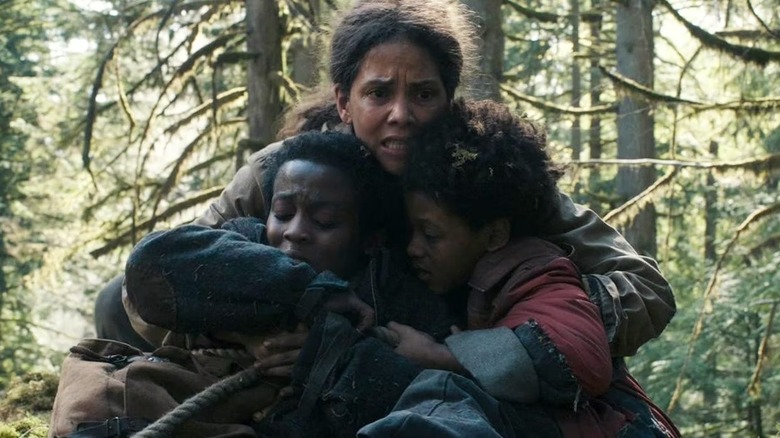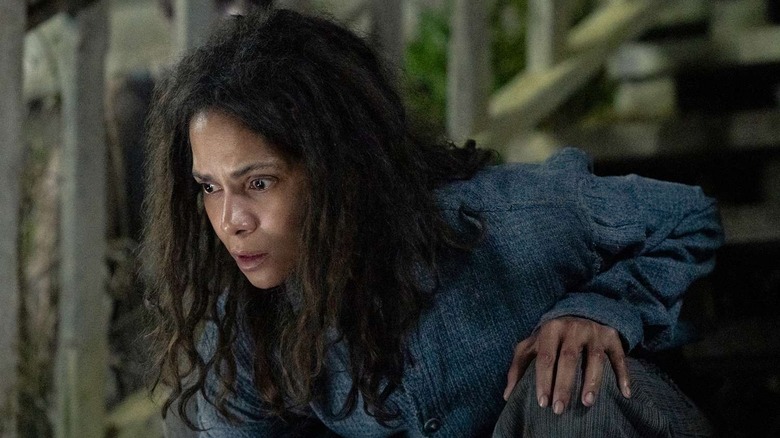Halle Berry Leads Alexandre Aja’s Creepy Fractured Fairytale

Once upon a time, there was a filmmaker named Alexandre Aja. His career was fascinating in the way it wasn’t strictly auteurist, for while every director has their unique stylistic tics and proclivities, not everyone has a distinctive, strong signature. Aja has certainly always been a genre filmmaker, one who’s interested in subversion and twists, in playing around with the conventions of genre, and in being unafraid to use audience’s sympathies against them. Whether it’s been in the brutal, New French Extremity slashers of “High Tension” and “The Hills Have Eyes,” the gleefully exploitative “Piranha 3D,” the literary roots of “Horns” and “The 9th Life of Louis Drax,” or the suspense exercises of “Crawl” and “Oxygen,” Aja has always found ways to surprise and upset (in every sense of the word) with his films.
All this is to say that, in the case of Aja’s latest film, “Never Let Go,” its logline and marketing campaign makes it appear to be part of the most recent theme he’s been exploring in his work, that of the suspense-forward genre exercise. In the same vein as “an alligator attack during a hurricane” and “a woman trapped inside an airtight cryogenic chamber” comes a mother (Halle Berry) who lives deep in a forest inside an old wooden house with her fraternal twin sons, Nolan (Percy Daggs IV) and Sam (Anthony B. Jenkins). The world has supposedly ended; these three are all that is left of humanity. To make matters worse, they cannot venture outside the house without tying a rope around themselves that is tethered to the home, for it’s the only defense they have against a raging Evil that has taken over the world, a force that can possess someone with a single touch and is irreversible. Somehow, through all this, they must find a way to survive.
While that premise and the trailer makes the film seem similar to the “A Quiet Place” franchise, “Never Let Go” has numerous surprises in store that make it something else entirely. Though its closest cousins are the works of M. Night Shyamalan as well as Trey Edward Shults’ “It Comes at Night,” Aja never presents the movie as a twisty “gotcha!” or as a morose “elevated” horror movie, but rather as a fractured fairy tale that keeps unfolding and revealing new layers, all of which give the film an eerie and powerful hold.
Never Let Go begins building its fairy tale from the first frames
Unlike Aja’s “High Tension,” “Never Let Go” is not a film which tricks you into thinking you’re watching one story when it’s actually showing you another. Yes, it’s filled with twists, reveals, and a ton of ambiguity, but this isn’t a rug-pull twist movie. That’s one of its charms, seeing as how its tone and structure are of a piece with the themes of the story. Right from the first minute, a voice-over narration from Nolan begins laying the fairy tale groundwork of the film, indicating that what we’re about to witness is not going to be strictly naturalistic. Even though Aja and writers KC Coughlin and Ryan Grassby lay it on a little thick at times — there’s a scene where Momma reads Nolan and Sam “Hansel and Gretel” — “Never Let Go” plays fair with its influences and its aesthetic aims.
Of course, fairy tales and horror are common bedfellows, so much so that several horror movies this year alone have heavily employed fairy tale elements. Thus, to put the movie in clearer terms: if “Longlegs” is urban legend and “The Front Room” ties together cultural mythology with the “evil stepmother” trope, “Never Let Go” examines its family unit’s fragile state through campfire tale logic mixed with religious zealotry. In addition to needing to keep ropes around themselves should they venture outside, Momma also makes sure that Nolan and Sam “recharge” the love within their ancestral home by sleeping in its small, cramped cellar for a particular amount of time. Should either Nolan or Sam be suspected of having been touched by the Evil and/or have disobeyed one of the rules, Momma makes them recite a specific mantra while touching the house’s wood, seemingly believing that someone infected with Evil would not be able to do such a thing.
If all of that sounds pretty tenuous as a belief system, then congratulations: you’re where Nolan begins the story, already suspicious of why he, his brother, and his mother are trapped inside a remote home deep in the woods with swiftly dwindling food and resources. In addition to the paranoia of “It Comes at Night” and the survivalist aspects of “A Quiet Place,” “Never Let Go” also examines the idea of faith from a similar perspective as Rose Glass’ “Saint Maud,” trying to look at belief in what seems like a bizarre and illogical system through the eyes of the faithful, who may be unreliable narrators by their very nature.
Halle Berry leads a self-effacing cast
Concurrent with this idea of blurring the lines of morality and even sanity within the characters, the three leads of the film each give a performance that’s notably without vanity. This is a movie where things start out fairly dangerous for the family unit and only get worse from there, not to mention the mercurial nature of each of their loyalties and their morality. So the fact that they’re all as engaging as they are is a testament to their abilities as performers. Jenkins and Daggs are real finds in particular; both boys have an intensity and vulnerability to them that allows them to hold the screen easily, and they may be my favorite child performances of the year so far.
For her part, Berry continues to make compelling and fascinating choices as an actress. They may not always work (see: her accent in 2000’s “X-Men”), but she can never be accused of not committing herself 100%. In “Never Let Go,” Berry seems totally unconcerned with making Momma likable or even wholly understandable; like her character, she’s unapologetically the way she is, take her or leave her. Even though the boys are the people we follow through the majority of the film, Berry’s Momma is the movie in miniature, refusing to be pigeonholed with just one interpretation or the other.
Aja makes a haunting film if you meet it halfway
As all of that indicates, “Never Let Go” is a heavily nuanced film, something which has the potential to frustrate audiences who are looking for a less complicated scary time. In addition, as with any story that’s part guessing game, half the fun is trying to predict where things might be going next, and it’s that aspect which Aja seems to subvert the most. Like I said, he plays fair; maybe too fair, because we’re given fairly concrete answers to some of the movie’s most major questions shockingly early. It’s just that these answers may not be the ones people are hoping for, or ones that fully satisfy them in the end.
Yet if you meet the film halfway, “Never Let Go” becomes enjoyably compelling and eerie. Yes, there are a good amount of scares to be had here, as Aja has only perfected his sense of jumpscare timing as well as his knack for finding collaborators who can conjure up some truly unsettling demonic zombie creatures (another key Aja collaborator, the composer ROB aka Robin Coudert, provides a richly layered combination electronic and orchestral score). Of course, your mileage may vary, but “Never Let Go” feels like the type of film which only grows in one’s estimation long after it’s ended. It has its immediate, visceral pleasures, to be sure. But as the title suggests, it may stick in your mind for days (or longer) afterward, as it has done in mine.
/Film Rating: 8.5 out of 10
“Never Let Go” opens September 20, 2024 in theaters everywhere.
Source link







